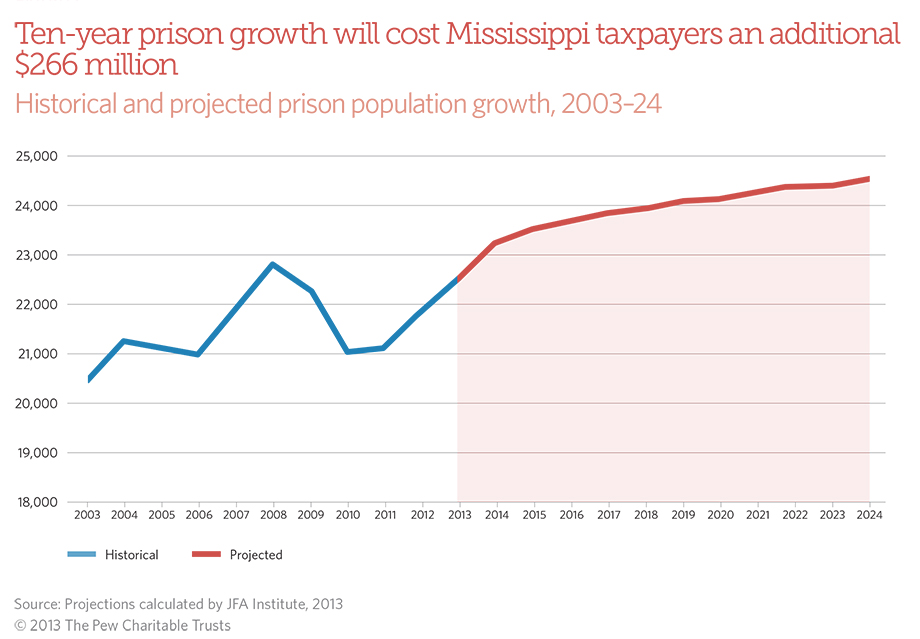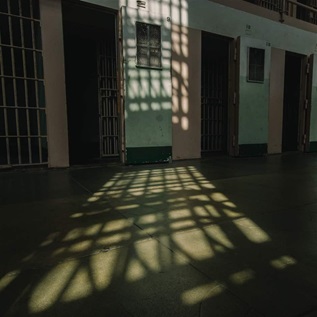Improving Public Safety and Containing Corrections Costs in Mississippi
Mississippi has one of the nation's highest and fastest-growing imprisonment rates, costing taxpayers hundreds of millions of dollars a year. Despite this spending, nearly a third of all nonviolent offenders released from prison return within three years. Absent systemic reform, this poor return on state taxpayers' investment will decline: Mississippi's prison population and corrections costs are projected to continue to grow in the next decade.
Seeking a better return on their public safety investment, state leaders established the bipartisan and interbranch Corrections and Criminal Justice Task Force to examine Mississippi's sentencing and corrections policies and propose substantive reforms that can hold offenders accountable and protect public safety, while controlling costs to taxpayers over the long-term.
Prison growth far outpaces the state's population growth
Mississippi's prison population has grown by 17 percent in the last decade and 307 percent in the past 30 years.1 The comparable figures for Mississippi's resident population are 4 and 29 percent, respectively. That is, prison growth in Mississippi was more than four times and almost eleven times faster than resident population growth, for the respective periods. The state now houses more than 22,600 prisoners and has the second-highest imprisonment rate in the country, trailing Louisiana.2
Prison growth has come at significant taxpayer expense
Mississippi taxpayers spend $339 million annually on corrections, up from $276 million in 2003. The vast majority—93 percent—pays for prisons, while the remainder funds probation, parole, and house arrest.
Mississippi's prison population projected to rise amid national decline
After peaking in 2008, the U.S. prison population declined for three consecutive years. According to the federal Bureau of Justice Statistics, the number of offenders in state prisons decreased 2.1 percent during 2012. The state imprisonment rate dropped by 2.6 percent.
In Mississippi, however, under current policies, the state's prison population is projected to grow by 1,990 inmates during the next decade at an additional cost of $266 million to state taxpayers.3 To accommodate this growth, the Mississippi Department of Corrections will need to reopen a prison.

Prison growth has not stopped the cycle of reoffending
Under current state policies and resource allocation, 31 percent – nearly one in every three - of all nonviolent offenders released from Mississippi prisons return within three years.4
Prison growth has not brought greater certainty in sentencing
An escalating prison population has prompted the state legislature to pass a series of earned time and release options to contain corrections costs. These policies have made it difficult for judges, prosecutors, other criminal justice stakeholders, and crime victims to predict the percentage of a given sentence that will be served behind bars. That diminished confidence in the certainty of prison time has fueled a cycle of longer initial sentences.
Prison spending crowds out other public safety priorities
While the state's prison budget consumes hundreds of millions of dollars, cost-effective public safety strategies that hold offenders accountable and reduce crime are in short supply in Mississippi. For example:
-
Just 7 percent of the total corrections budget supports community supervision for the nearly 40,000 felony offenders on probation, parole, and house arrest.
-
Research shows that drug courts, which employ a combination of treatment and supervision, can reduce recidivism, but funding for Mississippi drug courts was cut by 42 percent for fiscal 2014.5
-
More than 9,000 offenders leave state prisons each year, but Mississippi has no systemwide reentry programming and just three transitional reentry centers, which together have fewer than 100 beds.

What is driving the prison growth?
Mississippi's prison growth in the last decade has been largely driven by sentencing and corrections policies that send more nonviolent offenders to prison and keep them there longer.
Admissions to prison rose 35 percent during the past decade.6 Almost three-quarters of prison admissions in 2012 were offenders originally sentenced for nonviolent crimes. Many of these offenders were entering prison not because of a new criminal sentence but because of a technical revocation of probation or parole. In 2012, nearly 1 in 3 prison admissions was a nonviolent offender who violated the terms of his community supervision—testing positive for drugs or missing probation appointments, for example—as opposed to having received a new criminal sentence.7
The time inmates spend in prison has also grown substantially in the last decade. Perhaps because of the uncertainty about how much of the sentence will be served behind bars, judges have lengthened sentences significantly (28 percent) in the last decade. Even though earned time policies have resulted in a dramatic decrease in the percentage of the sentence served, this decrease has not offset the increase in sentence lengths: Offenders are now serving a smaller percentage of much longer sentences, ultimately leading to more time served in prison. For newly sentenced prisoners, time served in prison went up by 17 percent8 over the last decade. For some offenses, this growth is even more pronounced. Prison stays for drug possession offenders, for example, have increased 31 percent.9
Increases in admissions to prison and length of stay in prison for nonviolent offenders have contributed to a prison population that is nearly half nonviolent offenders.
Gearing up for action
| Task Force Goals The Corrections and Criminal Justice Task Force is undertaking a comprehensive review of the Mississippi corrections and criminal justice systems and developing cost-effective sentencing and corrections policies that: • Clarify sentencing laws and policies and strengthen community supervision to hold offenders accountable and improve the relationship between the corrections and criminal justice systems. • Control corrections costs by focusing prison space on violent, career criminals, and addressing the inefficiencies in the corrections and criminal justice systems. • Protect public safety by investing in programs, policies, and practices that reduce recidivism. |
Seeking new ways to protect public safety, hold offenders accountable, and control corrections costs, the Legislature passed and Governor Phil Bryant signed into law in April H.B. 1231, creating the Corrections and Criminal Justice Task Force. This bipartisan, interbranch working group is charged with undertaking a comprehensive review of the corrections and criminal justice system. The task force will meet seven times over seven months to analyze Mississippi's sentencing and corrections data; study existing policies, programs, and practices; and develop recommendations to earn taxpayers a better public safety return on each corrections dollar.
Chaired by Mississippi's commissioner of corrections, the task force includes Democratic and Republican legislators as well as judges, prosecutors, law enforcement officials, defense attorneys, a county supervisor, and a representative from the state attorney general's office.
The task force is receiving assistance from The Pew Charitable Trusts' public safety performance project as part of the Justice Reinvestment Initiative. Nearly two-dozen states—including Arkansas, Georgia, South Carolina, and Texas—have enacted justice reinvestment strategies to control their corrections spending and protect public safety by focusing their prison space on serious, chronic, and violent offenders and investing savings from averted prison growth into probation, parole, and other mandatory supervision practices such as drug courts that save taxpayer dollars and cut crime.
Endnotes
1 Prison population data 2003–13 from the Mississippi Department of Corrections; prison population data 1982-2012 from the Bureau of Justice Statistics, National Prisoner Series; and national population data from the U.S. Census Bureau.
2 Mississippi Department of Corrections, “Fact Sheet as of July 1, 2013,” http://www.mdoc.state.ms.us/Research%20and%20Statistics/MonthlyFactSheets/2013MFS/07-01-2013%20%20Fact%20Sheet.pdf; and Bureau of Justice Statistics, “Prisoners in 2012—Advance Counts,” http://www.bjs.gov/index.cfm?ty=pbdetail&iid=4737.
3 Wendy Naro Ware and Roger Ocker, Ten-Year Adult Secure Population Projection, 2004-14, Mississippi Department of Corrections (July 2013).
4 Ibid.
5 “Mississippi Will Cut Funding to Drug Courts,” Associated Press (June 11, 2013), http://www.cdispatch.com/news/article.asp?aid=24837&TRID=1&TID.
6 Independent analysis by The Pew Charitable Trusts' public safety performance project using Mississippi Department of Corrections data.
7 Ibid.
8 From an average of 29.2 months to an average of 34.1 months.
9 Ibid.











